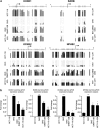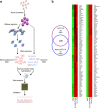DNA methylation determines nucleosome occupancy in the 5'-CpG islands of tumor suppressor genes
- PMID: 23686312
- PMCID: PMC3898323
- DOI: 10.1038/onc.2013.162
DNA methylation determines nucleosome occupancy in the 5'-CpG islands of tumor suppressor genes
Abstract
Promoter CpG island hypermethylation of tumor suppressor genes is an epigenetic hallmark of human cancer commonly associated with nucleosome occupancy and the transcriptional silencing of the neighboring gene. Nucleosomes can determine the underlying DNA methylation status. Herein, we show that the opposite is also true: DNA methylation can determine nucleosome positioning. Using a cancer model and digital nucleosome positioning techniques, we demonstrate that the induction of DNA hypomethylation events by genetic (DNMT1/DNMT3B deficient cells) or drug (a DNA demethylating agent) approaches is associated with the eviction of nucleosomes from previously hypermethylated CpG islands of tumor suppressor genes. Most importantly, the establishment of a stable cell line that restores DNMT1/DNMT3B deficiency shows that nucleosomes reoccupy their positions in de novo methylated CpG islands. Finally, we extend these results to the genomic level, combining a DNA methylation microarray and the nucleosome positioning technique. Using this global approach, we observe the dependency of nucleosome occupancy upon the DNA methylation status. Thus, our results suggest that there is a close association between hypermethylated CpG islands and the presence of nucleosomes, such that each of these epigenetic mechanisms can determine the recruitment of the other.
Figures




References
-
- Esteller M. Cancer epigenomics: DNA methylomes and histone-modification maps. Nat Rev Genet. 2007;8:286–298. - PubMed
-
- Portela A, Esteller M. Epigenetic modifications and human disease. Nat Biotechnol. 2010;28:1057–1068. - PubMed
-
- Li B, Carey M, Workman JL. The role of chromatin during transcription. Cell. 2007;128:707–719. - PubMed
Publication types
MeSH terms
Substances
LinkOut - more resources
Full Text Sources
Other Literature Sources
Molecular Biology Databases

